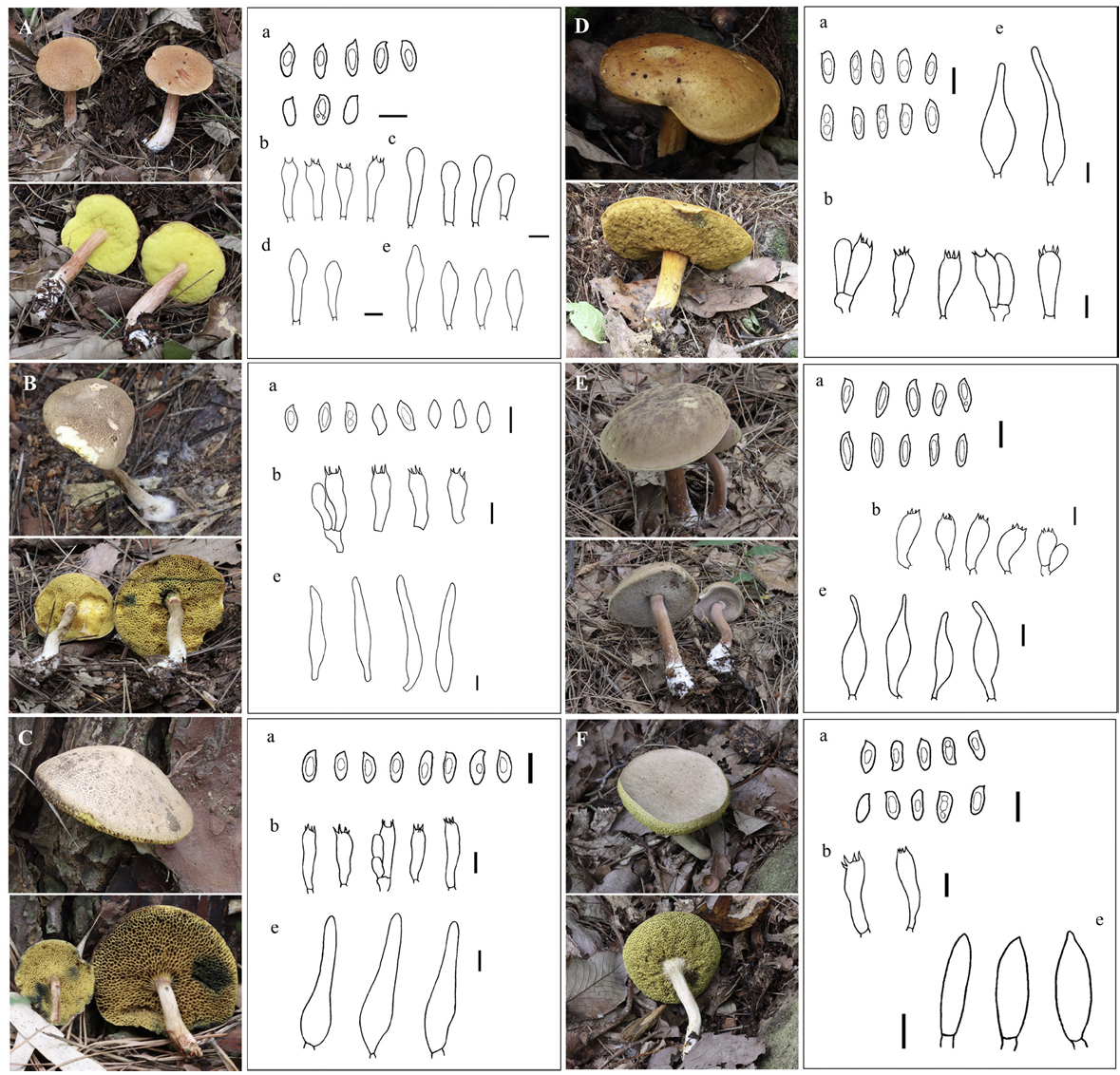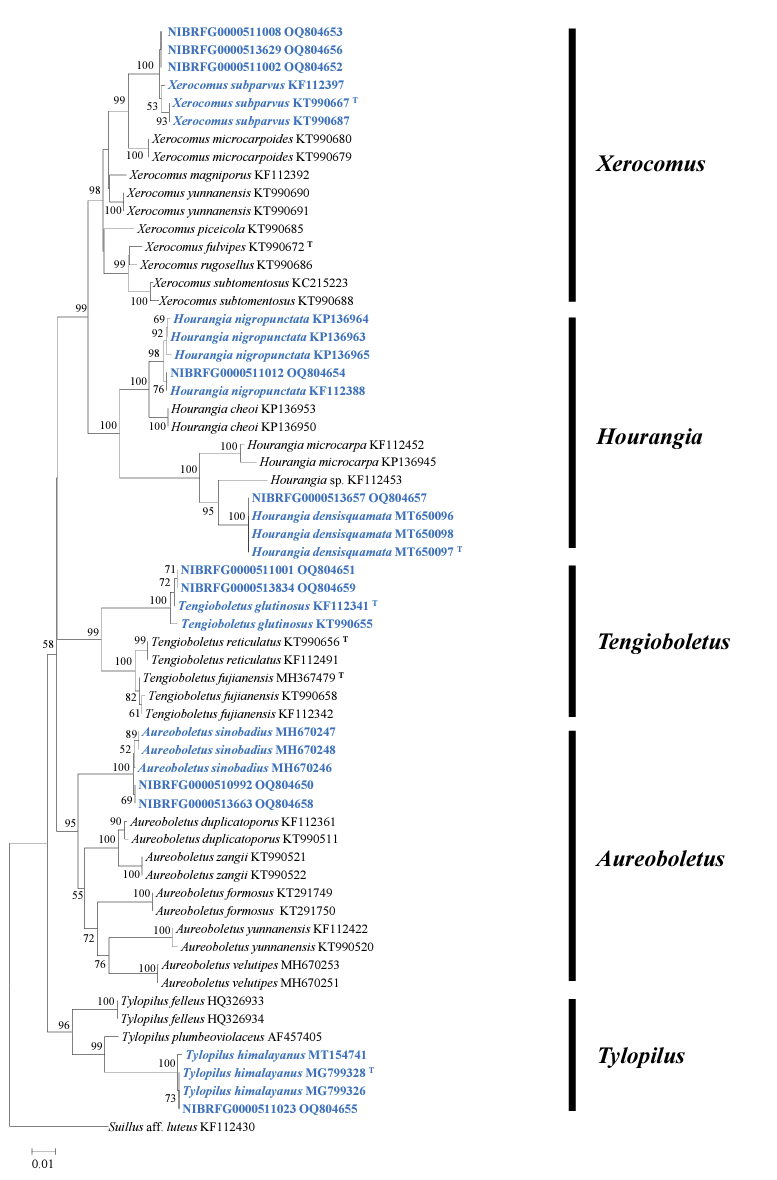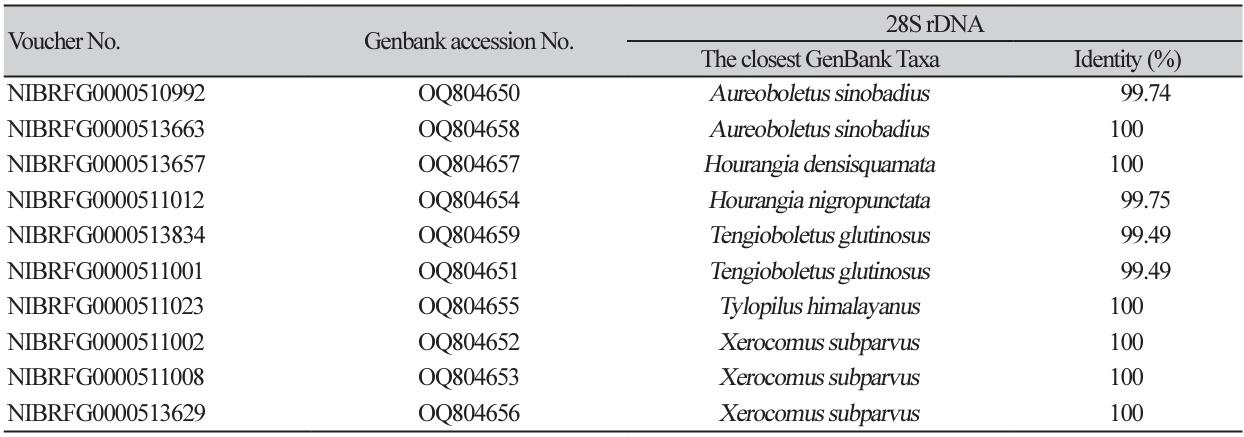INTRODUCTION
Mudeungsan National Park is located in Gwangju Metropolitan City (Buk-gu and Dong-gu) and Jeollanam-do (Hwasun-gun and Damyang-gun), South Korea, and has an area of 75.425 km2. The park provides habitats for several endangered species, Lutra lutra, Pteromys volans aluco, and Lindera sericea, etc and there have been several studies of plant and animal species in the park [1], but there has been little research regarding the fungal flora. The National Institute of Biological Resources conducted a fungal collection survey of Mudeungsan National Park from 2020 to 2022. About 351 mushroom specimens were obtained, among which species belonging to the Boletaceae Chevall. were analyzed in depth. The family Boletaceae is one of the most prominent and diverse basidiomycetes and primarily consists of ectomycorrhizal fungi, which play an essential ecological role in forest ecosystems. Members of the family are mainly tubulose with infrequent lamellate or loculate hymenophores and a fleshy appearance. Many mushrooms in the Boletaceae have attractive ornamentation on the cap, more ornamentation on the stalk, and various color changes in the fruiting body when bruised or cut [2]. The Boletaceae family is highly diverse, with about 50 genera and 800 species identified to date [3]. However, the numbers of genera and species are likely higher, as few studies have been in much of the tropics and subtropics. In Korea, 92 species in 22 genera of the Boletaceae have been reported to date [4]. New species and genera of Boletaceae have been continuously described in recent years. To secure, preserve and manage the genetic biological resources of higher fungi in Korea, a research project was carried out in Mudeungsan National Park. This study of macrofungal flora in Mudeungsan National Park added six new recorded species belonging to this group in Korea.
MATERIALS AND METHODS
All specimens were initially identified based on macroscopic and microscopic features, according to published descriptions [5-13]. Measurements and drawings were obtained using a Nikon Eclipse 80i microscope (Nikon, Tokyo, Japan). Twenty randomly selected mature basidiospores and basidia were evaluated from each specimen. For molecular identification, total DNA was extracted from the dried specimens using an AccuPrep Genomic DNA Extraction Kit (Bioneer, Daejeon, Korea). The nuclear large subunit rDNA D1-D2 domains (28S), specifically used for the molecular phylogenetic analysis of boletes, were amplified using the primer sets LR0R/LR5 or LR0R/LR7 [14,15]. DNA sequencing was performed at the Bioneer DNA Synthesis and Sequencing Facility (Daejeon, Korea) using the above primers. The nucleotide sequences were edited using MEGA 5 software [16] and deposited in GenBank. Species identification was confirmed by comparison with GenBank reference sequences using BLASTn. Neighborjoining phylogenetic analysis was performed using MEGA 5 software with Kimura 2-parameter correction. The robustness of the inferred neighbor-joining topologies was tested using 1,000 bootstrap replicates. Using a combination of morphological and phylogenetic analyses, all fungal taxa were enumerated and classified according to the current taxonomies. Taxonomic classification of species and associated nomenclature were assigned using the MycoBank database (http://www.mycobank.org/).
RESULTS
This survey identified 351 species of macrofungi in Mudeungsan National Park, which were classified into 2 phyla, 5 classes, 14 orders, 51 families, and 115 genera. Among them, 22 species belonged to the Boletaceae family. Six of these boletoid species, Aureoboletus sinobadius Zhang & Li, 2019; Hourangia densisquamata Zeng, Wang & Liang, 2020; H. nigropunctata (Chiu) Zhu & Yang, 2015; Tengioboletus glutinosus Wu & Yang, 2016; Tylopilus himalayanus Chakr., Das, & Vizzini, 2018; and Xerocomus subparvus Zhu & Yang, 2016, were recorded for the first time in Korea. Here, we present photographs of fruiting bodies, drawings of microscopic features (Fig. 1), and descriptions and discussions of these species.
Ten nucleotide sequences of these six species have been deposited in GenBank (accession numbers: OQ804650-OQ804659). The sequences were compared with GenBank reference sequences (Table 1) and identified via nuclear large subunit rDNA sequence analysis (Fig. 2).
Two specimens (NIBRFG0000510992 and NIBRFG0000513663) formed a monophyletic clade with the reference sequence of Aureoboletus sinobadius (bootstrap=100%; sequence similarity=100%). One specimen (NIBRFG0000513657) formed a monophyletic clade with the reference sequence of Hourangia densisquamata (bootstrap value=100%; sequence similarity=100%). One specimen (NIBRFG0000511012) formed a monophyletic clade with the reference sequence, Hourangia nigropunctata (bootstrap value=100%; sequence similarity: 99.8-100%). Two specimens (NIBRFG0000511001 and NIBRFG0000513834) formed a monophyletic clade with the reference sequence of Tengioboletus glutinosus (bootstrap=100%; sequence similarity: 99.8-100%). One specimen (NIBRFG0000511023) formed a monophyletic clade with the reference sequences of Tylopilus himalayanus (bootstrap support=100%; sequence similarity: 99.8-100.0%). Three specimens (NIBRFG0000511002, NIBRFG0000511008, and NIBRFG0000513629) formed a monophyletic clade with the reference sequences of Xerocomus subparvus (bootstrap support=100%; sequence similarity: 99.8-100.0%) (Fig. 2).

Fig. 1 Fruiting bodies and microscopic features of Aureoboletus sinobadius (A), Hourangia densisquamata (B), Hourangia nigropunctata (C), Tengioboletus glutinosus (D), Tylopilus himalayanus (E), and Xerocomus subparvus (F). a, basidiospores; b, basidia; c, basidioles; d, Cheilocystidia; e, Pleurocystidia. The scale bar is 10 μm in the microscopic images.

Fig. 2 Neighbor-joining tree of 6 unrecorded species constructed using Large subunit ribosomal ribonucleic acid (LSU rDNA). Bootstrap scores of >50 are presented at the nodes. The scale bar indicates the number of nucleotide substitutions per site. The unrecorded species are marked with asterisks. “T” indicates the type specimens.
Table 1 Closest GenBank matches of 6 undescribed species in this study.

TAXONOMY
DISCUSSION
Boletaceae Chevall, 1826 [17] is one of the most prominent and diverse families among basidiomycetes, with more than 70 genera [18]. Most Boletaceae species are valuable to humans, forming essential mutualistic symbioses with trees [19,20]. The phylogeny and classification of the Boletaceae have long been inconsistent because the morphology of Boletaceae has convergent characteristics. However, advances in molecular biology have led to the use of genealogical concordance phylogenetic species recognition [21] to identify fungal species, which has contributed to a better understanding of the relationships within this family. In addition, the species diversity of this family has increased significantly over the past few decades [2,20,22,23]. In the present study, based on a combination of morphological characteristics and rDNA sequence analyses, we discovered six newly recorded boletoid species in Korea. Fungi have a limited basidiocarp-forming period, making their collection and observation difficult. To overcome this issue, a long-term collection survey over a long period within a specific site is necessary, and it is expected that more species diversity will be obtained through such selective and intensive research.
